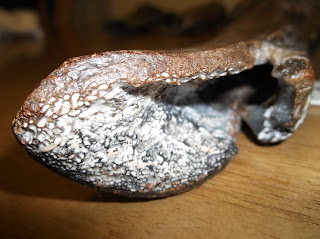 1 - This carved and used mineralised bone was found by myself in the very spot i found the first carved artefact six years ago.
1 - This carved and used mineralised bone was found by myself in the very spot i found the first carved artefact six years ago. 2 - It is easy to see the bone has been used by Humans as some sort of tool, the wear marks do not follow on around the bone, so this rules out some sort of peg used with twine.
2 - It is easy to see the bone has been used by Humans as some sort of tool, the wear marks do not follow on around the bone, so this rules out some sort of peg used with twine. 3 - The Artifact was found just down stream from a recent collaps of the Mesolithic Stainton gravel beds dated as being 12 - 16, 000ybp in age.
3 - The Artifact was found just down stream from a recent collaps of the Mesolithic Stainton gravel beds dated as being 12 - 16, 000ybp in age. 5 - The bottom fork like tine has been worn down and re carved at some point.
5 - The bottom fork like tine has been worn down and re carved at some point.HISTORY OF A BECK: Mesolithic tools and carved bones from the ...
HISTORY OF A BECK: Storregga slides Stunami theory




















































